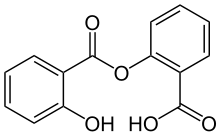Salsalate
Salsalate is a medication that belongs to the salicylate and nonsteroidal anti-inflammatory drug (NSAID) classes.
 | |
| Clinical data | |
|---|---|
| Trade names | Disalcid, Salflex |
| AHFS/Drugs.com | Monograph |
| MedlinePlus | a682880 |
| Pregnancy category |
|
| ATC code | |
| Legal status | |
| Legal status |
|
| Identifiers | |
IUPAC name
| |
| CAS Number | |
| PubChem CID | |
| DrugBank | |
| ChemSpider | |
| UNII | |
| KEGG | |
| ChEBI | |
| CompTox Dashboard (EPA) | |
| ECHA InfoCard | 100.008.208 |
| Chemical and physical data | |
| Formula | C14H10O5 |
| Molar mass | 258.23 g/mol g·mol−1 |
| | |
Salsalate is the generic name of a prescription drug marketed under the brandnames Mono-Gesic, Salflex, Disalcid, and Salsitab. Other generic and brand name formulations may be available.[1]
Mechanism of action
Relative to other NSAIDs, salsalate has a weak inhibitory effect on the cyclooxygenase enzyme and decreases the production of several proinflammatory chemical signals such as interleukin-6, TNF-alpha, and C-reactive protein.[2]
The mechanism through which salsalate is thought to reduce the production of these inflammatory chemical signals is through the inhibition of IκB kinase resulting in decreased action of NF-κB genes.[2][3][4] This mechanism is thought to be responsible for salsalate's insulin-sensitizing and blood sugar lowering properties.[3]
Medical uses
Salsalate may be used for inflammatory disorders such as rheumatoid arthritis or noninflammatory disorders such as osteoarthritis.[2][5]
Safety
The risk of bleeding is a common concern with use of the NSAID class of medications. However, the bleeding risk associated with salsalate is lower than that associated with aspirin use.[3]
Research
Salsalate has been proposed for the prevention and treatment of type 2 diabetes mellitus due to its ability to lower insulin resistance associated with inflammation and may be useful in prediabetes.[2] However, the use of salsalate to prevent the progression from prediabetes to type 2 diabetes mellitus has received limited study.[2]
Synthesis
References
- drugs.com Salsalate entry
- Anderson K, Wherle L, Park M, Nelson K, Nguyen L (June 2014). "Salsalate, an old, inexpensive drug with potential new indications: a review of the evidence from 3 recent studies". Am Health Drug Benefits. 7 (4): 231–5. PMC 4105730. PMID 25126374.CS1 maint: uses authors parameter (link)
- Esser N, Paquot N, Scheen AJ (March 2015). "Anti-inflammatory agents to treat or prevent type 2 diabetes, metabolic syndrome and cardiovascular disease". Expert Opin Investig Drugs (Review). 24 (3): 283–307. doi:10.1517/13543784.2015.974804. PMID 25345753.CS1 maint: uses authors parameter (link)
- Ridker PM, Lüscher TF (July 2014). "Anti-inflammatory therapies for cardiovascular disease". European Heart Journal. 35 (27): 1782–91. doi:10.1093/eurheartj/ehu203. PMC 4155455. PMID 24864079.CS1 maint: uses authors parameter (link)
- Hardie DG (July 2013). "AMPK: a target for drugs and natural products with effects on both diabetes and cancer". Diabetes. 62 (7): 2164–72. doi:10.2337/db13-0368. PMC 3712072. PMID 23801715.CS1 maint: uses authors parameter (link)
- Powell, Kendall (May 31, 2007). "The Two Faces of Fat". Nature. 447 (7144): 525–7. doi:10.1038/447525a. PMID 17538594.
- Ebstein, W (1876). "Zur therapie des diabetes mellitus, insbesondere uber die anwendung des salicylsauren natron bei demselben". Berliner Klinische Wochenschrift. 13: 337–340.
- Cavallito, Chester J.; Buck, Johannes S. (1943). "Synthesis of Phenolic Acid Esters. I. Depsides1". Journal of the American Chemical Society. 65 (11): 2140. doi:10.1021/ja01251a034.
- Baker, Wilson; Ollis, W. D.; Zealley, T. S. (1951). "42. Eight- and higher-membered ring compounds. Part II. Di-, tri-, tetra-, and hexa-salicylides". Journal of the Chemical Society (Resumed): 201. doi:10.1039/JR9510000201.
